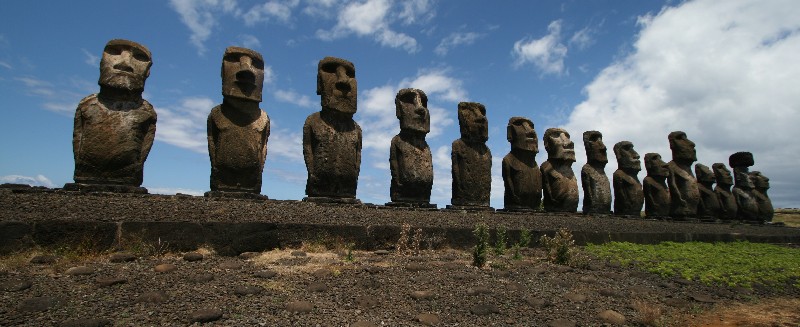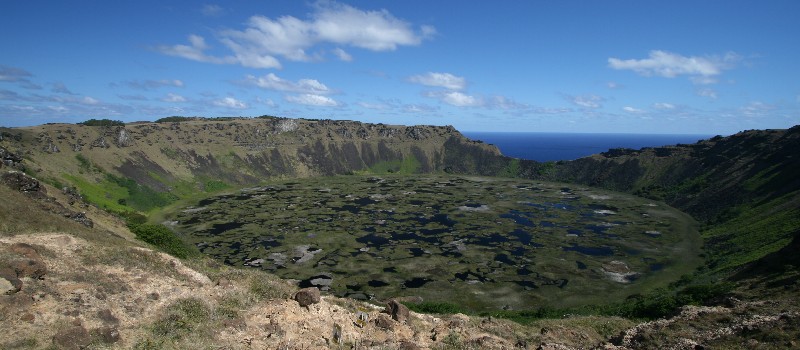Rano Kau - Rapa Nui

Rapa Nui:
Easter Island (Rapa Nui: Rapa Nui), (Spanish: Isla de Pascua) is a Polynesian island in the southeastern Pacific Ocean, at the southeastern most point of the Polynesian triangle.
It is a volcanic high island, consisting mainly of three extinct coalesced volcanoes: Terevaka (altitude 507 metres) forms the bulk of the island. Two other volcanoes, Poike and Rano Kau, form the eastern and southern headlands and give the island its roughly triangular shape. There are numerous lesser cones and other volcanic features, including the crater Rano Raraku, the cinder cone Puna Pau and many volcanic caves including lava tubes. Poike used to be an island until volcanic material from Terevaka united it to Easter Island. The island is dominated by hawaiite and basalt flows which are rich in iron and show affinity with igneous rocks found in Galapagos Islands.
Easter Island and surrounding islets such as Motu Nui, Motu Iti are the summit of a large volcanic mountain rising over two thousand metres from the sea bed. It is part of the Sala y Gómez Ridge, a (mostly submarine) mountain range with dozens of seamounts starting with Pukao and then Moai, two seamounts to the west of Easter Island, and extending 2,700 km (1,700 mi) east to the Nazca Seamount.
Pukao, Moai and Easter Island were formed in the last 750,000 years, with the most recent eruption a little over a hundred thousand years ago.
They are the youngest mountains of the Sala y Gómez Ridge, which has been formed by the Nazca Plate floating over the Easter hotspot. Alternative explanation is the activity of the Easter Fracture Zone. Only at Easter Island, its surrounding islets and Sala y Gómez does the Sala y Gómez Ridge form dry land.

Rano Kau:
Rano Kau is a 324 m (1,063 ft) tall extinct volcano that forms the southwestern headland of Easter Island, a Chilean island in the Pacific Ocean. It was formed of basaltic lava flows in the Pleistocene with its youngest rocks dated at between 150,000 and 210,000 years ago.
Rano Kau has a crater lake which is one of the island's only three natural bodies of fresh water. Most of the volcano is on the coast and has been eroded back to form high sea cliffs which at one point have started to bite into the crater wall. On its northern side, the volcano slopes down to Mataveri International Airport.
Rano Kau is in the world heritage site of Rapa Nui National Park and gives its name to one of the seven sections of the park. The principal archaeological site on Rano Kau is the ruined ceremonial village of Orongo which is located at the point where the sea cliff and inner crater wall converge. One ahu with several moai was recorded on the cliffs at Rano Kau in the 1880s, but had fallen to the beach by the time of the Routledge expedition in 1914.
As well as basalt, it contains several other igneous rocks including obsidian (for which it was one of the major sources for the island's stoneworkers) and pumice.
The crater is almost a mile across and has its own micro climate. Sheltered from the winds that dry most of the rest of the island, figs and vines flourish at Rano Kau.
At some point in the early twentieth century, the island's manager took a photograph of steam coming out of the crater wall.
Reference: Wikipedia

To log this Earthcache answers the following questions by mail:
At the coordinates you stand at the crater edge.
1. Which colors have the rocks among your feet?
2. On the rocks you see some parasites. Which color do they have? Describe their form.
3. How deep is the crater lake?
All other logs will be deleted.
Please upload with your log a picture with you and the GPS in the hand and the crater lake in the background.
